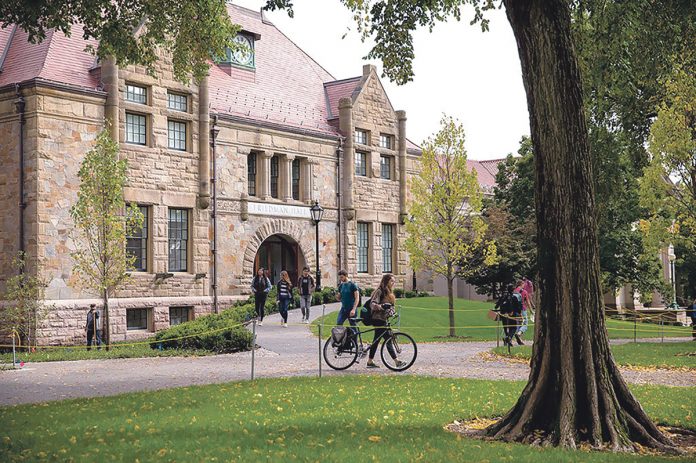
PROVIDENCE – The Corporation of Brown University has approved a 5 percent increase in undergraduate tuition and fees, bringing the total to $73,736 for the academic year beginning next fall, the university announced.
The increase was approved during the corporation’s three-day winter meeting held Feb. 7-9, during which it also approved measures to eliminate campus greenhouse gas emissions over the next two decades, including taking immediate steps to cut emissions by 75 percent by 2025. The corporation is composed of the school’s 12-member board of fellows and 42-member board of trustees.
The corporation set the following undergraduate prices for the 2019-20 academic year: tuition: $57,112, a 5.1 percent increase; standard room rate: $9,420, a 3.3 percent increase; standard board: $5,912, a 6.5 percent increase; health fee: $942, a 6.3 percent increase; student activities fee: $286, unchanged; and student recreation fee: $64, unchanged, for a total of $73,736.
In addition to raising tuition and fees, the corporation approved a $1.2 billion operating budget for fiscal 2020 that includes $143.1 million for undergraduate financial aid.
Provost Richard M. Locke said the new budget includes more funds for recruiting faculty and staff, infrastructure to complement university research, programs for students, and other investments.
“The strategic priorities supported through this year’s budget reflect Brown’s ongoing dedication to supporting an exceptional student experience, building Brown’s excellence in research and scholarship, and developing the physical campus in support of these goals,” Locke said.
Regarding the new zero greenhouse gases plan, Brown President Christina Paxson said: “The best available science tells us that the world needs to cut its emissions dramatically by mid-century or sooner to avert the most catastrophic effects of climate change.
“With our pledge to reach net-zero [emissions], and with a plan that is ambitious yet technically and financially feasible, Brown will be a leader in addressing a defining challenge for the 21st century,” Paxson added.
According to a Brown spokesman, the university has produced an average of 53,600 metric tons per year of greenhouse gases, such as carbon dioxide and methane, over the past three years. That’s equivalent to emissions from about 10,000 cars.
Previously, Brown committed in 2008 to reducing its emissions by nearly half from 2007 levels by 2020.
Brown is approaching its emissions reduction goal for 2020 after the conversion of the university’s central heating plant from oil to natural gas, a thermal efficiency upgrade that enabled the plant to circulate hot water instead of steam, and a variety of other campus energy-efficiency projects, the university said.
Meanwhile, the first phase of the new zero emissions plan is already in motion.
It involves two renewable-energy agreements with providers of solar and wind power to offset all of Brown’s campus electricity use. Last month, Brown finalized a partnership to create a 50-megawatt solar facility at a former gravel pit in North Kingstown, expected to offset 70 percent of its campus electricity use. The remaining 30 percent will be offset by an agreement with a Texas-based wind farm, the university said.
The second phase of the emissions plan, scheduled for 2022, will convert the central heating plant to bio-oil as a primary fuel, with natural gas remaining as a backup. Bio-oil is produced from waste cooking oil discarded after food preparation.
The third phase involves more upgrades of the university’s central heating loop and buildings connected to it between 2021 and 2038. The final phase, scheduled for 2038, calls for the conversion of the heating plant to renewable electricity, with bio-oil as a secondary fuel.
The goal is to completely eliminate campus greenhouse gas emissions by 2040.
“It’s not an easy thing for a large, complex organization like a university to dramatically change the way it operates,” said Leah VanWey, associate provost for academic space at Brown and a professor of sociology, environment, and society.
Scott Blake is a PBN staff writer. Email him at Blake@PBN.com.












